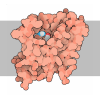[English] 日本語
 Yorodumi
Yorodumi- PDB-7r0w: 2.8 Angstrom cryo-EM structure of the dimeric cytochrome b6f-PetP... -
+ Open data
Open data
- Basic information
Basic information
| Entry | Database: PDB / ID: 7r0w | |||||||||||||||
|---|---|---|---|---|---|---|---|---|---|---|---|---|---|---|---|---|
| Title | 2.8 Angstrom cryo-EM structure of the dimeric cytochrome b6f-PetP complex from Synechocystis sp. PCC 6803 with natively bound lipids and plastoquinone molecules | |||||||||||||||
 Components Components |
| |||||||||||||||
 Keywords Keywords |  PHOTOSYNTHESIS / PHOTOSYNTHESIS /  Complex / Complex /  cytochrome / cytochrome /  membrane protein / membrane protein /  electron transport electron transport | |||||||||||||||
| Function / homology |  Function and homology information Function and homology information : / : /  cytochrome b6f complex / cytochrome b6f complex /  electron transporter, transferring electrons within cytochrome b6/f complex of photosystem II activity / cytochrome complex assembly / photosynthetic electron transport chain / plasma membrane-derived thylakoid membrane / electron transporter, transferring electrons within the cyclic electron transport pathway of photosynthesis activity / electron transporter, transferring electrons within cytochrome b6/f complex of photosystem II activity / cytochrome complex assembly / photosynthetic electron transport chain / plasma membrane-derived thylakoid membrane / electron transporter, transferring electrons within the cyclic electron transport pathway of photosynthesis activity /  photosynthesis / respiratory electron transport chain / membrane => GO:0016020 ... photosynthesis / respiratory electron transport chain / membrane => GO:0016020 ... : / : /  cytochrome b6f complex / cytochrome b6f complex /  electron transporter, transferring electrons within cytochrome b6/f complex of photosystem II activity / cytochrome complex assembly / photosynthetic electron transport chain / plasma membrane-derived thylakoid membrane / electron transporter, transferring electrons within the cyclic electron transport pathway of photosynthesis activity / electron transporter, transferring electrons within cytochrome b6/f complex of photosystem II activity / cytochrome complex assembly / photosynthetic electron transport chain / plasma membrane-derived thylakoid membrane / electron transporter, transferring electrons within the cyclic electron transport pathway of photosynthesis activity /  photosynthesis / respiratory electron transport chain / membrane => GO:0016020 / photosynthesis / respiratory electron transport chain / membrane => GO:0016020 /  electron transfer activity / iron ion binding / electron transfer activity / iron ion binding /  heme binding / heme binding /  metal ion binding metal ion bindingSimilarity search - Function | |||||||||||||||
| Biological species |   Synechocystis (bacteria) Synechocystis (bacteria)  Synechocystis sp. PCC 6803 (bacteria) Synechocystis sp. PCC 6803 (bacteria) | |||||||||||||||
| Method |  ELECTRON MICROSCOPY / ELECTRON MICROSCOPY /  single particle reconstruction / single particle reconstruction /  cryo EM / Resolution: 2.8 Å cryo EM / Resolution: 2.8 Å | |||||||||||||||
 Authors Authors | Farmer, D.F. / Proctor, M.S. / Malone, L.A. / Swainsbury, D.P.K. / Hawkings, F.R. / Hitchcock, A. / Johnson, M.P. | |||||||||||||||
| Funding support |  United Kingdom, 4items United Kingdom, 4items
| |||||||||||||||
 Citation Citation |  Journal: Biochem J / Year: 2022 Journal: Biochem J / Year: 2022Title: Cryo-EM structures of the Synechocystis sp. PCC 6803 cytochrome b6f complex with and without the regulatory PetP subunit. Authors: Matthew S Proctor / Lorna A Malone / David A Farmer / David J K Swainsbury / Frederick R Hawkings / Federica Pastorelli / Thomas Z Emrich-Mills / C Alistair Siebert / C Neil Hunter / Matthew ...Authors: Matthew S Proctor / Lorna A Malone / David A Farmer / David J K Swainsbury / Frederick R Hawkings / Federica Pastorelli / Thomas Z Emrich-Mills / C Alistair Siebert / C Neil Hunter / Matthew P Johnson / Andrew Hitchcock /  Abstract: In oxygenic photosynthesis, the cytochrome b6f (cytb6f) complex links the linear electron transfer (LET) reactions occurring at photosystems I and II and generates a transmembrane proton gradient via ...In oxygenic photosynthesis, the cytochrome b6f (cytb6f) complex links the linear electron transfer (LET) reactions occurring at photosystems I and II and generates a transmembrane proton gradient via the Q-cycle. In addition to this central role in LET, cytb6f also participates in a range of processes including cyclic electron transfer (CET), state transitions and photosynthetic control. Many of the regulatory roles of cytb6f are facilitated by auxiliary proteins that differ depending upon the species, yet because of their weak and transient nature the structural details of these interactions remain unknown. An apparent key player in the regulatory balance between LET and CET in cyanobacteria is PetP, a ∼10 kDa protein that is also found in red algae but not in green algae and plants. Here, we used cryogenic electron microscopy to determine the structure of the Synechocystis sp. PCC 6803 cytb6f complex in the presence and absence of PetP. Our structures show that PetP interacts with the cytoplasmic side of cytb6f, displacing the C-terminus of the PetG subunit and shielding the C-terminus of cytochrome b6, which binds the heme cn cofactor that is suggested to mediate CET. The structures also highlight key differences in the mode of plastoquinone binding between cyanobacterial and plant cytb6f complexes, which we suggest may reflect the unique combination of photosynthetic and respiratory electron transfer in cyanobacterial thylakoid membranes. The structure of cytb6f from a model cyanobacterial species amenable to genetic engineering will enhance future site-directed mutagenesis studies of structure-function relationships in this crucial ET complex. | |||||||||||||||
| History |
|
- Structure visualization
Structure visualization
| Structure viewer | Molecule:  Molmil Molmil Jmol/JSmol Jmol/JSmol |
|---|
- Downloads & links
Downloads & links
- Download
Download
| PDBx/mmCIF format |  7r0w.cif.gz 7r0w.cif.gz | 424 KB | Display |  PDBx/mmCIF format PDBx/mmCIF format |
|---|---|---|---|---|
| PDB format |  pdb7r0w.ent.gz pdb7r0w.ent.gz | 349.6 KB | Display |  PDB format PDB format |
| PDBx/mmJSON format |  7r0w.json.gz 7r0w.json.gz | Tree view |  PDBx/mmJSON format PDBx/mmJSON format | |
| Others |  Other downloads Other downloads |
-Validation report
| Arichive directory |  https://data.pdbj.org/pub/pdb/validation_reports/r0/7r0w https://data.pdbj.org/pub/pdb/validation_reports/r0/7r0w ftp://data.pdbj.org/pub/pdb/validation_reports/r0/7r0w ftp://data.pdbj.org/pub/pdb/validation_reports/r0/7r0w | HTTPS FTP |
|---|
-Related structure data
| Related structure data |  14224MC  7zxyC  13584 M: map data used to model this data C: citing same article ( |
|---|---|
| Similar structure data | Similarity search - Function & homology  F&H Search F&H Search |
- Links
Links
- Assembly
Assembly
| Deposited unit | 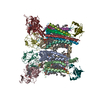
|
|---|---|
| 1 |
|
- Components
Components
-Protein , 4 types, 8 molecules XVIAKCDL
| #1: Protein | Mass: 7231.374 Da / Num. of mol.: 2 Source method: isolated from a genetically manipulated source Source: (gene. exp.)   Synechocystis (bacteria) / Strain: PCC 6714 / Gene: cp097, D082_20950 / Plasmid: pET28a / Details (production host): 5' 6xHis tag / Production host: Synechocystis (bacteria) / Strain: PCC 6714 / Gene: cp097, D082_20950 / Plasmid: pET28a / Details (production host): 5' 6xHis tag / Production host:   Escherichia coli BL21 (bacteria) / References: UniProt: A0A068MZK2 Escherichia coli BL21 (bacteria) / References: UniProt: A0A068MZK2#2: Protein |  Cytochrome b Cytochrome bMass: 25075.533 Da / Num. of mol.: 2 / Source method: isolated from a natural source / Source: (natural)   Synechocystis sp. PCC 6803 (bacteria) / Strain: PCC 6803 / Kazusa / References: UniProt: Q57038 Synechocystis sp. PCC 6803 (bacteria) / Strain: PCC 6803 / Kazusa / References: UniProt: Q57038#4: Protein |  Mass: 35259.340 Da / Num. of mol.: 2 / Source method: isolated from a natural source / Source: (natural)   Synechocystis sp. PCC 6803 (bacteria) / Strain: PCC 6803 / Kazusa / References: UniProt: P26287 Synechocystis sp. PCC 6803 (bacteria) / Strain: PCC 6803 / Kazusa / References: UniProt: P26287#9: Protein | Mass: 20562.344 Da / Num. of mol.: 2 / Source method: isolated from a natural source / Source: (natural)   Synechocystis sp. PCC 6803 (bacteria) Synechocystis sp. PCC 6803 (bacteria) |
|---|
-Cytochrome b6-f complex subunit ... , 4 types, 8 molecules JBNFOGPH
| #3: Protein | Mass: 17455.783 Da / Num. of mol.: 2 / Source method: isolated from a natural source / Source: (natural)   Synechocystis sp. PCC 6803 (bacteria) / Strain: PCC 6803 / Kazusa / References: UniProt: P27589 Synechocystis sp. PCC 6803 (bacteria) / Strain: PCC 6803 / Kazusa / References: UniProt: P27589#6: Protein/peptide | Mass: 3827.555 Da / Num. of mol.: 2 / Source method: isolated from a natural source / Source: (natural)   Synechocystis sp. PCC 6803 (bacteria) / Strain: PCC 6803 / Kazusa / References: UniProt: P74810 Synechocystis sp. PCC 6803 (bacteria) / Strain: PCC 6803 / Kazusa / References: UniProt: P74810#7: Protein/peptide | Mass: 4177.004 Da / Num. of mol.: 2 / Source method: isolated from a natural source / Source: (natural)   Synechocystis sp. PCC 6803 (bacteria) / Strain: PCC 6803 / Kazusa / References: UniProt: P74149 Synechocystis sp. PCC 6803 (bacteria) / Strain: PCC 6803 / Kazusa / References: UniProt: P74149#8: Protein/peptide | Mass: 3328.965 Da / Num. of mol.: 2 / Source method: isolated from a natural source / Source: (natural)   Synechocystis sp. PCC 6803 (bacteria) / Strain: PCC 6803 / Kazusa / References: UniProt: P72717 Synechocystis sp. PCC 6803 (bacteria) / Strain: PCC 6803 / Kazusa / References: UniProt: P72717 |
|---|
-Protein/peptide , 1 types, 2 molecules ME
| #5: Protein/peptide |  Cytochrome b Cytochrome bMass: 3376.149 Da / Num. of mol.: 2 / Source method: isolated from a natural source / Source: (natural)   Synechocystis sp. PCC 6803 (bacteria) / References: UniProt: A0A6P1VG96 Synechocystis sp. PCC 6803 (bacteria) / References: UniProt: A0A6P1VG96 |
|---|
-Non-polymers , 13 types, 29 molecules 
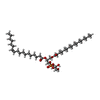

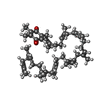

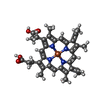



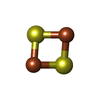















| #10: Chemical | ChemComp-HEM /  Heme B Heme B#11: Chemical | ChemComp-PGV / (  Phosphatidylglycerol Phosphatidylglycerol#12: Chemical |  Echinenone Echinenone#13: Chemical |  Plastoquinone Plastoquinone#14: Chemical |  Chlorophyll a Chlorophyll a#15: Chemical |  Heme C Heme C#16: Chemical | ChemComp-LMG / | #17: Chemical | #18: Chemical | ChemComp-2WA / ( | #19: Chemical |  Iron–sulfur cluster Iron–sulfur cluster#20: Chemical | #21: Chemical | ChemComp-LFA / |  Icosane Icosane#22: Water | ChemComp-HOH / |  Water Water |
|---|
-Details
| Has ligand of interest | Y |
|---|
-Experimental details
-Experiment
| Experiment | Method:  ELECTRON MICROSCOPY ELECTRON MICROSCOPY |
|---|---|
| EM experiment | Aggregation state: PARTICLE / 3D reconstruction method:  single particle reconstruction single particle reconstruction |
- Sample preparation
Sample preparation
| Component | Name: Cytochrome b6f complex in association with PetP / Type: COMPLEX / Type: COMPLEXDetails: strep-PetA used to purify cytochrome b6f complex from Synechocystis sp. PCC 6803. 6xHis-PetP recombinantly expressed in E. coli used to pull down cytochrome b6f complex and form the cytochrome b6f-PetP complex. Entity ID: #1-#9 / Source: MULTIPLE SOURCES | |||||||||||||||||||||||||
|---|---|---|---|---|---|---|---|---|---|---|---|---|---|---|---|---|---|---|---|---|---|---|---|---|---|---|
| Source (natural) | Organism:   Synechocystis sp. PCC 6803 (bacteria) Synechocystis sp. PCC 6803 (bacteria) | |||||||||||||||||||||||||
| Buffer solution | pH: 7.6 | |||||||||||||||||||||||||
| Buffer component |
| |||||||||||||||||||||||||
| Specimen | Conc.: 4 mg/ml / Embedding applied: NO / Shadowing applied: NO / Staining applied : NO / Vitrification applied : NO / Vitrification applied : YES : YESDetails: Sample was monodisperse but not present in every hole | |||||||||||||||||||||||||
| Specimen support | Grid material: COPPER / Grid mesh size: 300 divisions/in. / Grid type: Quantifoil R1.2/1.3 | |||||||||||||||||||||||||
Vitrification | Instrument: LEICA EM GP / Cryogen name: ETHANE / Humidity: 70 % / Chamber temperature: 288 K |
- Electron microscopy imaging
Electron microscopy imaging
| Experimental equipment |  Model: Titan Krios / Image courtesy: FEI Company |
|---|---|
| Microscopy | Model: FEI TITAN KRIOS |
| Electron gun | Electron source : :  FIELD EMISSION GUN / Accelerating voltage: 300 kV / Illumination mode: FLOOD BEAM FIELD EMISSION GUN / Accelerating voltage: 300 kV / Illumination mode: FLOOD BEAM |
| Electron lens | Mode: BRIGHT FIELD Bright-field microscopy / Nominal magnification: 81000 X / Nominal defocus max: 2400 nm / Nominal defocus min: 1200 nm / Cs Bright-field microscopy / Nominal magnification: 81000 X / Nominal defocus max: 2400 nm / Nominal defocus min: 1200 nm / Cs : 2.7 mm / C2 aperture diameter: 50 µm / Alignment procedure: COMA FREE : 2.7 mm / C2 aperture diameter: 50 µm / Alignment procedure: COMA FREE |
| Specimen holder | Specimen holder model: FEI TITAN KRIOS AUTOGRID HOLDER |
| Image recording | Average exposure time: 3.5 sec. / Electron dose: 50 e/Å2 / Film or detector model: GATAN K3 BIOQUANTUM (6k x 4k) / Num. of grids imaged: 1 / Num. of real images: 20133 |
| EM imaging optics | Energyfilter name : GIF Bioquantum / Energyfilter slit width: 20 eV : GIF Bioquantum / Energyfilter slit width: 20 eV |
- Processing
Processing
| Software |
| ||||||||||||||||||||||||||||||||||||
|---|---|---|---|---|---|---|---|---|---|---|---|---|---|---|---|---|---|---|---|---|---|---|---|---|---|---|---|---|---|---|---|---|---|---|---|---|---|
| EM software |
| ||||||||||||||||||||||||||||||||||||
CTF correction | Type: PHASE FLIPPING AND AMPLITUDE CORRECTION | ||||||||||||||||||||||||||||||||||||
| Particle selection | Num. of particles selected: 1169445 | ||||||||||||||||||||||||||||||||||||
| Symmetry | Point symmetry : C1 (asymmetric) : C1 (asymmetric) | ||||||||||||||||||||||||||||||||||||
3D reconstruction | Resolution: 2.8 Å / Resolution method: FSC 0.143 CUT-OFF / Num. of particles: 152860 / Algorithm: FOURIER SPACE / Num. of class averages: 1 / Symmetry type: POINT | ||||||||||||||||||||||||||||||||||||
| Atomic model building | Protocol: RIGID BODY FIT / Space: REAL | ||||||||||||||||||||||||||||||||||||
| Atomic model building | PDB-ID: 7PPW 7ppw | ||||||||||||||||||||||||||||||||||||
| Refinement | Cross valid method: NONE Stereochemistry target values: GeoStd + Monomer Library + CDL v1.2 | ||||||||||||||||||||||||||||||||||||
| Displacement parameters | Biso mean: 93 Å2 | ||||||||||||||||||||||||||||||||||||
| Refine LS restraints |
|
 Movie
Movie Controller
Controller



 PDBj
PDBj





